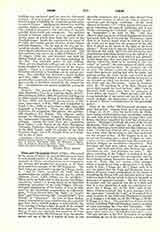

Urim and Thummim (Hebrew: AVRYM VTMYM).—The sacred lot by means of which the ancient Hebrews were wont to seek manifestations of the Divine will. Two other channels of Divine communication were recognized, viz. dreams and prophetical utterance, as we learn from numerous passages of the Old Testament. The three forms are mentioned together in I Kings, xxviii, 6. “And he (Saul) consulted the Lord, and he answered him not, neither by dreams, nor by priests (Hebrew, Urim, LXX, delois), nor by prophets.”
There can be no doubt that in this instance the Douay translation “priests” is wrong, based on the mistaken rendering “sacerdotes” of the Latin Vulgate. The etymological signification of the words, at least as indicated by the Massoretic punctuation, is sufficiently plain. Urim is derived from Hebrew: AYR, “light”, or “to give light”, and Thummim from Hebrew: TM, “completeness”, “perfection”, or “innocence”. In view of these derivations it is surmised by some scholars that the sacred lot may have had a twofold purpose in trial ordeals, viz. Urim serving to bring to light the guilt of the accused person, and Thummim to establish his innocence. Be that as it may, the relatively few mentions of Urim and Thummim in the Old Testament leave the precise nature and use of the lot a matter of more or less plausible conjecture, nor is much light derived from the ancient versions in which the term is subject to uncertain and divergent renderings. In the xxviii chapter of Exodus (“P”) where minute directions are given concerning the priestly vestments, and in particular concerning the “rational” (probably “pouch” or “breastplate”) we read (v. 30): “And thou (Moses) shalt put in the rational of judgment doctrine and truth (Heb. the Urim and the Thummim), which shall be on Aaron‘s breast when he shall go in before the Lord; and he shall bear the judgment of the children of Israel on his breast in the sight of the Lord always.” From this it appears that at least towards the close of the Exile, the Urim and Thummim were considered as something distinct from the ephod of the high priest and the gems with which it was adorned. It also shows that they were conceived of as material objects sufficiently small to be inserted in the “rational” or “pouch”, the main purpose of which seems to have been to receive them. In Leviticus, viii, 7-8 we read: “He (Moses) vested the high priest with the strait linen garment, girding him with the girdle, and putting on him the violet tunick, and over it he put the ephod, and binding it with the girdle, he fitted it to the rational, on which was doctrine and truth” (Heb. the Urim and the Thummim). Again in Numbers xxvii, 21: “If anything be to be done, Eleazar the priest shall consult the Lord for him” (Heb. “and he [Eleazar] shall invoke upon him the judgment of Urim before the Lord”). These passages add little to our knowledge of the nature and use of the oracle, except perhaps the importance attached to it as a means of Divine communication in the post-Exilic period.
Some of the earlier Old-Testament passages are more instructive. Among these may be mentioned I Samuel, xiv, 41-2. After the battle with the Philistines during which Jonathan had unwittingly violated the rash oath of his father, Saul, by tasting a little wild honey, the latter consulted the Lord but received no answer. Desiring to ascertain the cause of the Divine. displeasure, Saul calls together the people in order that the culprit may be revealed and thus addresses the Lord: “O Lord God of Israel, give a sign, by which we may know, what the meaning is, that thou answerest not thy servant today. If this iniquity be in me, or in my son Jonathan, give a proof (Vulgate da ostensionem= Urim): or if this iniquity be in thy people, give holiness (Vulgate da sanctitatem=Thummim). And Jonathan and Saul were taken, and the people escaped. And Saul said: Cast lots between me and Jonathan my son. And Jonathan was taken.” The above rendering of the Vulgate is confirmed by the Greek recension of Lucian (see ed. Lagarde), and by the evidently corrupt Massoretic thamim at the end of verse 41. From this and various other passages which it would be too long to discuss here (v. g. Deut. xxxiii, 8, Heb., I Kings, xiv, 36, I Kings, xxiii, 6-12 etc.) we gather that the Urim and Thummim were a species of sacred oracle manipulated by the priest in consulting the Divine will, and that they were at times used as a kind of Divine ordeal to discover the guilt or innocence of suspected persons. The lots being two in number, only one question was put at a time, and that in a way admitting of only two alternative answers (see I Kings, xiv, 41-42; ibid., xxiii, 6-12). Many scholars maintain that in most passages where the expression “consult the Lord” or its equivalent is used, recourse to the Urim and Thummim is implied (v. g. Judges, i, 1-2; ibid., xx, 27-28; I Kings, x, 19-22; II Kings, Ii, 1, etc.). The speculations of later Jewish writers including Philo and Josephus teach us nothing of value concerning the Urim and Thummim. They are often fanciful and extravagant, as is the case with many other topics (see “Jewish Encyclopedia“, s.v.). The only instance in the New Testament of anything resembling the use of the sacred lot as a means to discover the Divine will occurs in the Acts (i, 24-26) in connection with the election of Matthias.
JAMES F. DRISCOLL

